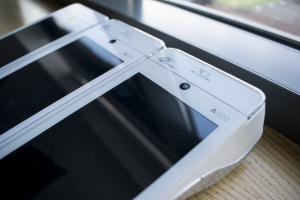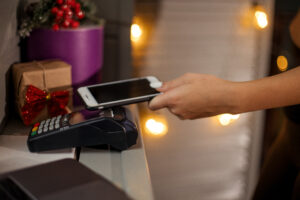At Bespoke Merchant Solutions, we understand it can be difficult...
The Contactless Limit is Raised, your Business will Need to Know Some Details.
Discover more
The Crucial Shift to Cashless Transactions for SMEs
In the ever-changing landscape of small to medium-sized businesses (SMEs),...
A Merchant’s Guide to a Successful Christmas
We understand the challenges that come with the influx of...
The Importance of Accommodating Digital Wallet Payments
In 2021, 90% of card transactions were contactless payments. Apps...
Monek: Our New Trusted Partner Bank
We are excited to announce that BMS is venturing on...
The Financial Conduct Agency raised the maximum spending contactless limit on each use of a card from £45 to £100 in October. This can raise threats and opportunities for your business and consumers, which aren’t always noticed right away. We can help you identify and bring awareness to these possible outcomes, and how you as a merchant can help your customers.
What are the benefits of the increased contactless limit?
- This change is better for your business, as it will raise more opportunities than risks to you and your consumers.
- The limit increase from £45 to £100 could make business owners’ and their customers’ lives easier – if they have the right technology in place.
- It could cut down queues – during peak hours, there may be considerable queues of customers waiting to pay. A higher contactless card threshold will mean faster service and more sales in less time.
- Customers are already used to limitless contactless spending – consumers are used to contactless payments. If companies don’t keep up with consumer needs, they could soon be left behind.
- It reduces unnecessary contact – During the pandemic, people reduced their contact points to help stop the spread, and most customers could feel more comfortable and safer using contactless where they can.
What are the potential risks of a higher contactless limit, and how we can help?
- May cause potential to alienate audiences that only use cash – Though this shouldn’t be too much risk with modernity taking over society, cashless payments are becoming ‘the norm’. Official figures show 7 million people led a ‘cashless life’ in 2020, while payments made using cash dropped by 35 percent. It is also suggested that up to 80 percent of small and medium-sized businesses are expected to still accept cash over the next five years.
- More customers and higher revenue, but this may distract you from risk management – We have our account managers for that, who will also cover PCI issues if there are higher customers coming through with their own data.
- Consumers could potentially be at more risk of fraud – It is important to note that no payment method is entirely secure, including contactless payments. Contactless payments don’t add any more security risk when paying for higher value items and are on the same level as chip and pin payments. We are also aware that the UK’s contactless fraud rates are low, and there are limits, such as the number of times you can make a consecutive payment.
Highstreet banks are aware that the public may be uncomfortable with this decision. With that, most banks have provided the option to limit the contactless spending amount or turn off contactless payments altogether.
The transition to the £100 contactless limit could take months, as each business must make changes in their systems to offer the increased limit. At BMS, we have the machines to handle contactless, but you may still need to activate the £100 limit. If you have any questions, please do not hesitate to contact us.
What should merchants do to protect themselves and their customers?
Despite the multiple benefits of increasing the contactless card limit, some customers may still have concerns about this change. Consumers may also be worried about losing track of spending. As a merchant, you can do a few things to ensure that paying customers rust they have their security in mind.
1. Show the transaction total on a screen
Contactless tapping can often be rapid, and consumers can forget to check the card machine screen to verify how much they’ve been charged.
The transaction total should be made clear to ensure that it is what the customer expects. Merchants can verbally communicate the total to customers on the EPOS screen before they tap.
2. Always offer receipts
Consumers are more likely to skip the paper receipt for their daily coffee, as it becomes a waste product. However, when it comes to higher-value purchases made on contactless, customers should always have proof of purchase so they can check their statements and keep track of their outgoings.
This may help businesses avoid the risk of merchant chargebacks. If customers identify an unfamiliar charge from a contactless transaction they forgot about, retailers and shoppers will have proof of purchase.
3. Become PCI compliant
PCI DSS compliance refers to the Payment Card Industry Data Security Standard, which is a mandatory requirement for all business owners accepting credit and debit cards. We take our commitment to keeping customers’ data safe from fraudulent activity seriously. Knowing about PCI compliance is crucial when you run a business. To learn more about it, click here.
If you’re yet to find a payment solution, learn more about our swift and effortless merchant services.
Get in touch today and find out how we can help you Do Business Better!

Payment & Merchant Insights
How to Effectively Manage Multiple Card Machines
At Bespoke Merchant Solutions, we understand it can be difficult to manage multiple card machines, however it is crucial for
February 29, 2024

Payment & Merchant Insights
The Crucial Shift to Cashless Transactions for SMEs
In the ever-changing landscape of small to medium-sized businesses (SMEs), staying ahead of the curve is imperative for sustained success.
January 23, 2024

Payment & Merchant Insights
A Merchant’s Guide to a Successful Christmas
We understand the challenges that come with the influx of customers during festive periods. Let’s unwrap some tips and tricks
November 14, 2023




